Indices For Oral Disease Definitions
Index
A numerical value describing the relative status of a population on a graduated scale with definite upper and lower limits, which is designed to permit and facilitate comparison with other populations classified by the same criteria and methods
Indices For Oral Disease Important Notes
1. Gingival index scoring

2. Periodontal index scoring
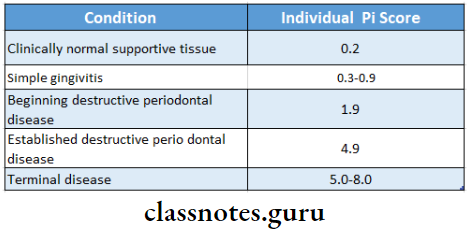
Read And Learn More: Percentive Communitive Dentistry Question And Answers
3. Scoring System

4. Treatment needs scoring
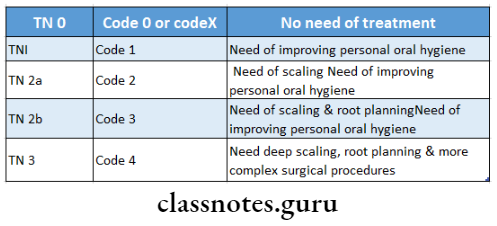
5. Dean’s fluorosis index scoring
(or) A scoring pattern of Dean’s index.

6. Teeth examined in indices
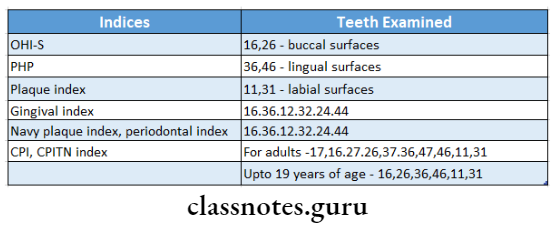
Indices For Oral Diseases
7. HO modifications of DMF index
- All third molars are included
- Temporary restorations are considered D
- Only carious cavities are considered
8. Indicators of periodontal status used in CPI are
- Gingival bleeding
- Calculus
- Periodontal pockets
9. Periodontal index by Russell measures the presence/ absence of
- Gingival inflammation
- Pocket formation
- Masticatory function
10. Classification of index
- Based on the direction in which their scores can fluctuate
- Irreversible index
- Reversible index
- Depending upon the extent to which areas of the oral cavity are measured
- Full mouth index

Read And Learn More: Percentive Communitive Dentistry Question And Answers
- Simplified index
- General categories
- Disease index
- Symptom index
- Treatment Index
- Special categories
- Simple index
- Cumulative index
11.Properties of index
- Clarity, simplicity, and objectivity
- Validity
- Reliability
- Quantifiability
- Sensitivity
- Acceptability
Indices For Oral Disease Long Essays
Question 1. Define indexes and classify them. Write about its ideal requisites.
(or) Classify various indices of the oral cavity. (or )Ideal requirements of index.
Answer:
Indexes Definition:
A numerical value describing the relative status of a population on a graduated scale with definite upper and lower limits, which is designed to permit and facilitate comparison with other populations classified by the same criteria and methods
Classification of Indexes :
- Based on the direction in which their scores can fluctuate
- Irreversible index
- An index that measures conditions whose scores will not decrease on subsequent examination.
- Example: DMFT index
- Reversible index
- An index that measures conditions that can increase or decrease on subsequent examination. Ex. Gingival index
- Depending upon the extent to which areas of the oral cavity are measured
- Full mouth index
- Those indices measure the patient’s entire dentition. Example: PI
- Simplified index
- These indices measure only a representative sample of the dental apparatus. Example: OH1-S
- General categories
- Disease index
- D- portion of DMFT index
- Disease index
- Symptom index
- Measuring gingiva/sulcular bleeding
- Treatment Index
- F portion of the DMFT index
- Special categories
- Simple index
- Measures the presence or absence of a condition
- Simple index
- Cumulative index
- Measures all the evidence of a condition, past or present
Indexes Ideal Requisites:
1. Clarity, simplicity and objectivity:
- The examiner should remember the rules of the index clearly
- The index should be simple and easy to apply
- The criteria should be objective
2. Validity:
- The index should measure what it is intended to measure
- Validity should correspond to the clinical stages of the disease under study
3. Reliability:
The index should be measured consistently at different times and under a variety of conditions
4. Quantifiability:
The index should be amenable to statistical analysis so that the status can be expressed by a number
5. Sensitivity:
The index should be able to detect small shifts in either direction
6. Acceptability:
The use of an index should not be painful or demeaning to the subject
Dental Indices Questions And Answers
Question 2. Define an index and describe the CPITN index
(or) Define index. Describe the CPITN with its objectives, scoring system, advantages, and limitations.
Answer:
Index Cpitn Index
Index Objectives:
- To survey and evaluate periodontal treatment needs
- identify actual and potential problems posed by periodontal diseases both in the community and in the individual
Index Advantages:
- Simplicity
- Speed
- International uniformity
Index Limitations:
- Does not record the position of the gingival margin
- Does not provide an assessment of past periodontal breakdown
Index Procedure:
- The dentition is divided into sextants for assessment of periodontal treatment needs
- Each sextant is given a score
Index Sextants:

Index Probing Procedure:
- A tooth is probed to determine pocket depth and to detect subgingival calculus and bleeding response
- The probe is inserted between the tooth and the gingival, and the sulcus depth or pocket depth is noted against the color
- A tooth should be probed in at least 6 points, the mesiobuccal, distobuccal, and corresponding sites on lingual surfaces
Code and Criteria

Question 3. Classify them. Add a note on the DMFT and DMFS index and on its limitations.
Answer:
Dmft Index:
Developed by Henry T Klein, Carole E Palmer and Knutson ] W in 1938
Dmft Index Components:
- D- used to describe decayed teeth
- M- used to missing teeth due to decay
- F- used to describe a number of teeth attacked by caries but which have been restored
Dmft Index Calculation:
- Individual DMFT= D+M+F
- Group average
- Total DMF / total number of subjects examined
Dmft Index Limitations:
- Not related to the number of teeth at risk
- Invalid in an older individual
- Misleading in children
- Overestimate caries experience in teeth
- Little use in root caries
- Equates a disease state with a healthy state
Dmfs Index:
Dmft Index Components:
- D- used to describe decayed teeth surface
- M- used to missing teeth surface due to decay
- F- used to describe the number of teeth surfaces attacked by caries but which have been restored
Dmft Index Calculation:
- If 28 teeth are examined
- 16 posterior teeth[16*5)= 80 surfaces
- 12 anterior teeth( 12*4)= 48 surfaces
- Total= 128 surfaces
- If third molars are included (4*5)= 20 surfaces
- Total= 148 surfaces
Dmft Index Limitations:
- Time-consuming
- Likely to produce inconsistencies in diagnosis
- May require the use of a radiograph
Indices For Oral Disease Short Essays
Question 1. Dean’s fluorosis index.
Answer:
Dean’s fluorosis index
- Introduced by Trendley H dean in 1934
- Dean’s fluorosis index is an index for the assessment of dental fluorosis
- Dean’s fluorosis index is the most widely used fluorosis index since 1942
Oral Hygiene Index Questions
Question 2. Oral hygiene index.
Answer:
Oral hygiene index
Described by John C. Greene and Jack R. Vermillion in 1960
Oral Hygiene Index Methodology:
- Components
- Debris index
- Calculus index
- The dental arch is divided into three segments
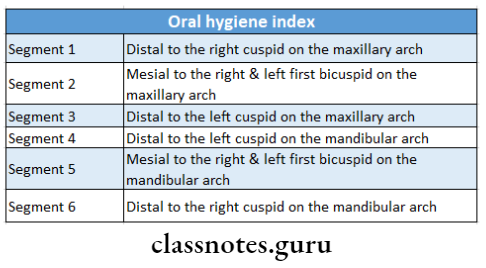
The surface covered by debris and calculus is estimated
Scoring For Dl-S:
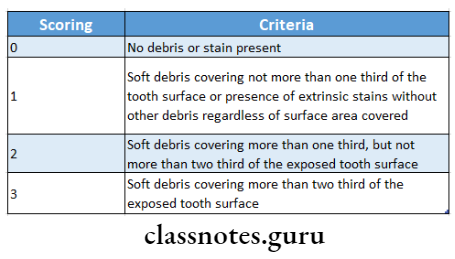
Scoring For Cl-S:
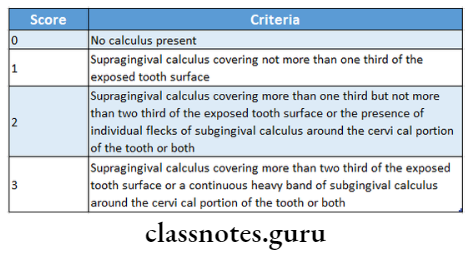
Interpretation For Dl-S and Cl-S:
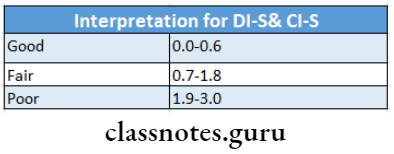
Interpretation For OHI:
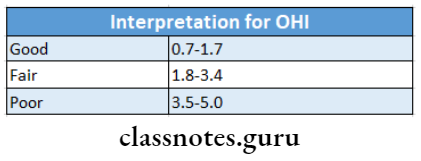
Question 3. Composite index.
Answer:
Composite index
The periodontal index is a composite index because it records both the reversible changes due to gingivitis and irreversible changes brought about by periodontal disease
Composite Index Method:
- Teeth examined
- All teeth present are assessed for gingival inflammation and periodontal involvement
- Scoring is given
Composite Index Calculation:
PI score per person = sum of individual score/number of teeth present
Question 4. Oral hygiene index-simplified.
Answer:
The oral hygiene index simplified
Described by John C.Greene and Jack R.Vermillion in 1964
Index-simplified Tooth Examined:
- 16/17,11,16/27
- 46/47,31,36/37
index-simplified Surfaces Examined:
- Facial surfaces of 16/17,11, 26/27, 31
- Lingual surfaces of 36/37,46/47
index-simplified Sites:
- DI-S- incisal third to gingival third
- CI-S – distal gingival crevice subgingivally from distal to mesial contact
Dental Caries Index Questions
Question 5. Loe and Sillness index.
Answer:
Stillness Index Teeth Examined:
All or selected teeth
Stillness Index Surfaces:
- Distal facial papillae
- Facial margin
- Mesial facial papillae
- Lingual margin
Scoring:

Stillness Index Calculation:
- For individual tooth
- Score / 4
- For individual person
- Total score/ total teeth examined
Interpretation:
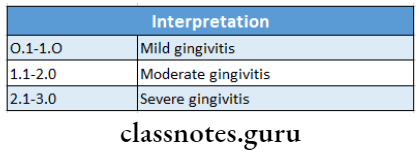
Question 6. Caries index for primary dentition.
Answer:
Primary Dentition Def Index:
- Described by Gruebbel A.O. in 1944
- d- decayed tooth e
- e-extracted tooth e
- f- filled tooth
Primary Dentition Examination Method:
- d- decayed teeth
- e-extracted teeth
- Indicates those deciduous teeth that have been extracted due to caries or which have badly decayed that they are indicated for extraction
- f-filled teeth
- Indicates the number of deciduous teeth that have been attacked by caries but which have been restored without any recurrent decay present
Primary dentition Calculation:
- For deciduous teeth 20 teeth are present
- For the def index maximum score is 20
- For deaths maximum score is 88, it is as follows
- 8 posterior teeth(8*5)= 40 surfaces
- 12 anterior teeth( 12*4)= 48 surfaces
Question 7. Define index. Write notes on DMFT and DMFS.
Answer:
Dmft Index:
Developed by Henry T Klein, Carole E palmer and Knutson J W in 1938
Dmft Index Components:
- D- used to describe decayed teeth
- M- used to missing teeth due to decay
- F- used to describe a number of teeth attacked by caries but which have been restored
Dmft Index Calculation:
- Individual DMFT= D+M+F
- Group average
- Total DMF / total number of subjects examined
Dmfs Index:
Components:
- D- used to describe decayed teeth surface
- M- used to missing teeth surface due to decay
- F- used to describe a number of teeth surfaces attacked by caries but which have been restored
Dmft Index Calculation:
- If 28 teeth are examined
- 16 posterior teeth(16*5)= 80 surfaces
- 12 anterior teeth( 12*4)= 48 surfaces
- Total= 128 surfaces
- If third molars are included (4*5)= 20 surfaces
- Total= 148 surfaces
Indices Used In Epidemiology Dentistry
Indices For Oral Disease Short Question And Answers
Question 1. DMF index.
Answer:
DMF index
Developed by Henry T Klein, Carole E palmer and Knutson J W in 1938
DMF index Components
- D- used to describe decayed teeth
- M- used to missing teeth due to decay
- F- used to describe the number of teeth attacked by caries but which have been restored
DMF index Limitations:
- Not related to the number of teeth at risk
- Invalid in an older individual
- Misleading in childer
- Overestimate carries experience in teeth
- Little use in root caries
- Equates a disease state with a healthy state
Question 2. Community fluorosis index.
Answer:
Community fluorosis index
- Devised by Trendley H. Dean in 1946
- It is to calculate the prevalence and severity of fluorosis in a group or community
- Index = nXw/N
- Where
- n= number of individuals in each category
- w= weighting for each category
- N= total population
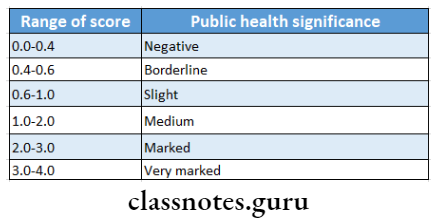
Question 3. Uses of PI.
Answer:
Uses of PI
- Estimate deeper periodontal disease
- Measure the presence or absence of gingival inflammation and its severity
- Pocket formation
- Masticatory function
Oral Hygiene Index Questions
Question 4. Validity of index.
Answer:
Validity of index
- The index should measure what it is intended to measure
- It should correspond to the clinical stages of the disease under study
Indices For Oral Disease Viva Voce
- Def index measures dental caries in the primary dentition.
- Cumulative indices measure all the evidence of past and present condition
- The gingival index is also known as Loe and Silness and the Plaque index is also known as Silness and Loe index
- The periodontal disease index is given by Ramfjord
- Sulcus bleeding index and papillary bleeding index measure gingival bleeding
- The weight of the CPITN probe is 5 grams
- The length of the CPITN probe is 14 mm
- In DMFT, decayed tooth include
- A tooth with caries below the existing restoration
- A tooth with a temporary restoration
- An index measuring the periodontal disease of an individual is classified under a composite index
- Plaque index is an example of a reversible index
- The plaque index measures the thickness of plaque at the gingival third
- Russell periodontal index does not measure gingival recession
